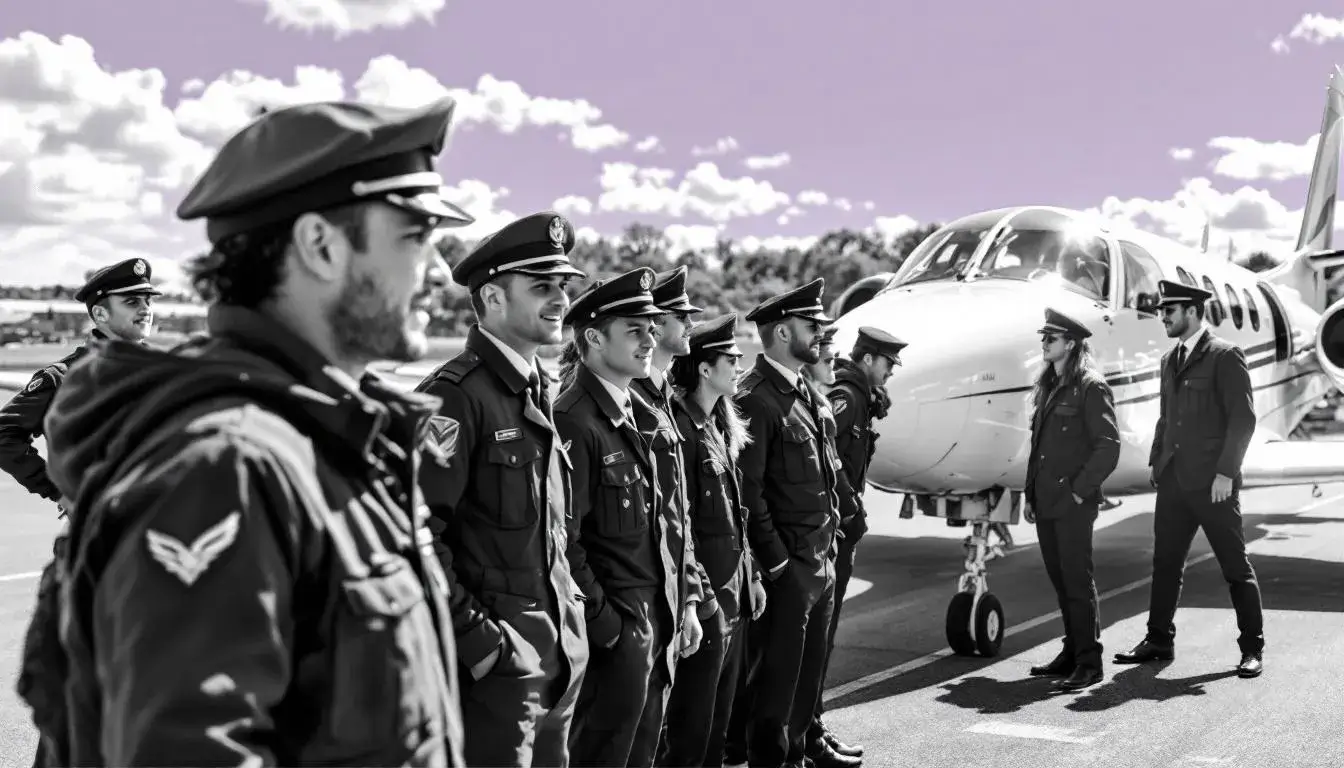
Finance for Pilot Training

The price of the dream, explained clearly
Pilot training in the UK is a significant financial commitment, often the largest investment a trainee will make before their first airline job. In 2025, typical costs run from £60,000 to £150,000 depending on the route you choose. Integrated, airline-focused courses sit at the higher end, while modular paths can be more flexible but may take longer. Against a European backdrop of €50,000 to €140,000, the UK sits toward the upper range, reflecting our market’s focus on integrated training and premium facilities.
Understanding APR is not just about percentages - it is about what you will really repay over time and how that aligns with early-career pilot salaries. Loans can bridge the upfront gap with payment holidays until employment, but obligations start soon after you qualify, which can tighten cash flow in your first years on the line. Meanwhile, scholarships, apprenticeships and sponsorships are evolving, with the Department for Transport considering new funding models to widen access and address shortages. Capacity is tight too, with only around 900 to 1,600 UK training places each year, so planning early and securing a seat matters.
The right finance is the one you can repay comfortably while building flight hours and experience.
The long-term outlook is encouraging. Boeing forecasts strong global pilot demand through 2043, which underpins the case for investing in your training if you can secure terms that make sense. Government initiatives, including targeted grants and outreach funding, aim to reduce barriers and diversify the cockpit. Your decision should blend realism about costs with a clear-eyed view of career prospects and risk.
Who will benefit from this guide
This guide is for UK residents considering a Private Pilot Licence through to commercial training, from school leavers to career changers. If you are comparing integrated versus modular routes, exploring loans, or weighing scholarships and airline pathways, you will find practical, UK-specific context here. Parents and guardians supporting trainees will also gain clarity on timelines, repayments and risk. We outline funding choices, how applications work, and what to watch for in terms and conditions so you can proceed with confidence.
Your funding menu
Personal savings or family support
Unsecured pilot training loans with payment holidays
Secured personal loans via a broker like Kandoo
Airline sponsorship or cadet schemes when available
Apprenticeships and employer-backed training models
Scholarships, bursaries and charitable grants
Modular training to spread cost over time
Part-time work plus staged training and hour building
Cost, impact and outcomes at a glance
| Option | Typical cost range | Monthly impact during training | Long-term returns | Key risks |
|---|---|---|---|---|
| Personal savings/family | £20,000-£150,000 depending on route | Minimal monthly outflow beyond living costs | No interest paid, faster break-even | Opportunity cost of cash, limited liquidity |
| Unsecured loan | £25,000-£75,000 per facility, may combine | Payment holiday possible, interest accrues | Builds credit, access to integrated courses | Higher APR than secured, early repayments bite |
| Secured loan via broker | £50,000-£150,000 depending on security | Lower APR, structured repayments | Predictable costs, larger borrowing possible | Asset at risk if repayments missed |
| Airline sponsorship/cadet | Heavily subsidised to full funding | Low during training, bonding likely | Direct pathway to airline placement | Competitive entry, clawbacks if leaving early |
| Apprenticeship | Employer contributes to training | Earn while learning, reduced outlay | Industry experience plus qualification | Limited availability, longer timeline |
| Scholarships/grants | £500-£30,000+ patchwork funding | Offsets fees without repayments | Improves access and diversity | Not guaranteed, time-consuming applications |
| Modular route | £60,000-£110,000 spread over stages | Pay-as-you-go matches progress | Flexibility to work and train | Longer duration, coordination complexity |
Who is eligible and what lenders look for
Eligibility varies by product, but lenders typically assess UK residency, age over 18, income or projected income, credit history and any security offered. For unsecured loans, stable income, clean credit and a credible training plan help. Secured loans may allow larger sums at lower rates if you can offer property or other acceptable collateral. Some providers allow payment holidays until you secure your first flying job, but they will price for risk and interest usually accrues throughout.
Airline schemes and apprenticeships apply their own criteria, often focusing on aptitude, academic ability and psychometric testing. Scholarships and grants are competitive and may target widening participation. If you are comparing multiple avenues, a broker like Kandoo can help you understand affordability, term length, representative APR and any early repayment charges in a single view. Always confirm that your chosen ATO is reputable, with high completion rates and strong airline links, as outcomes influence both employability and your ability to repay.
Step-by-step to secure funding
Map your route - integrated or modular, UK or EU.
Build a full budget - tuition, exams, living, travel, contingencies.
Shortlist ATOs - compare results, fleet, placement data.
Check eligibility - credit, income, collateral, residency.
Seek quotes - unsecured, secured, sponsorships, grants.
Compare APR and terms - holidays, ERCs, deferrals, fees.
Run stress tests - delayed employment and salary scenarios.
Apply and document - offers, ID, training plan, affordability checks.
Pros, cons and fine print
| Item | Pros | Cons |
|---|---|---|
| Unsecured loan | Fast access, no collateral needed | Higher APR, stricter affordability checks |
| Secured loan | Larger sums, lower APR potential | Asset risk, valuation and legal costs |
| Airline sponsorship | Direct pathway, reduced fees | Bonding, limited intakes, performance pressure |
| Apprenticeship | Earn while training, structured support | Longer path, limited locations |
| Scholarships/grants | Non-repayable funds | Competitive, partial coverage only |
| Modular training | Flexibility, pay-as-you-go | Longer timeline, self-management burden |
| Integrated training | Cohesive syllabus, strong airline links | Highest cost, intensive schedule |
| Family funding | No interest, flexible terms | Relationship risk, concentrated exposure |
Read this before you sign
Training costs in the UK often exceed £60,000 and can reach £150,000, so small differences in APR, fees and repayment timing have outsized effects on total cost. Early repayment charges, capitalisation of interest during payment holidays and deferral conditions deserve close attention. Consider training capacity constraints - there are only about 900 to 1,600 UK places annually - and how delays might extend your budget. Low advertised prices can mask compromises such as fewer instructor hours or weaker airline links. Balance cost against completion rates, safety culture and employment outcomes. Build a contingency fund for retakes, medical renewals and living costs during type rating or line training.
Alternative routes if Plan A slips
Start modular with a PPL while saving for the CPL/IR.
Train in lower-cost EU locations with UK licence conversion plan.
Join the military then transition to civil flying later.
Pursue aviation degrees with integrated practical modules.
Gain ground roles in airlines while applying to cadet schemes.
Frequently asked questions
Q: How much should I budget in total for UK pilot training?
A: Most trainees should plan for £70,000 to £150,000 including exams, equipment and living costs. Integrated courses sit toward the higher end.
Q: Are UK loans available with payment holidays until I get a job?
A: Yes, some lenders offer deferrals or holidays, but interest usually accrues and repayments may step up quickly after qualification.
Q: Is modular training genuinely cheaper?
A: It can be, because you pay in stages and can work between phases. Total cost depends on pace, aircraft rates and retake frequency.
Q: What government support exists right now?
A: The government has funded outreach and is exploring apprenticeships and alternative models. Direct full-fee funding is limited, so plan for mixed sources.
Q: How do UK costs compare with Europe?
A: The UK is typically at the higher end. EU modular routes can be cheaper, but consider travel, conversion and regulatory alignment.
Q: Will pilot demand support taking on debt?
A: Long-term demand is strong globally, which supports the investment, but you should stress test repayments against conservative salary assumptions.
Ready to move forward
If funding a cockpit career is your next step, compare offers carefully, then apply with confidence. Kandoo can introduce you to a range of lenders, so you can check eligibility, compare representative APRs and choose terms that suit your training plan without impacting your credit score with multiple hard searches.
Important information
This guide is for information only and is not financial advice. Finance is subject to status, affordability and lender criteria. Terms may change. Always read the SECCI and full agreement before committing.
Buy now, pay monthly
Buy now, pay monthly
Some of our incredible partners
Our partners have consistently achieved outstanding results. The numbers speak volumes. Be one of them!


SPLASHING OUT BATHROOMS LIMITED

UMBRELLA BATHROOMS










